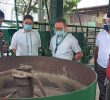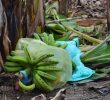Earlier, PBGEA president Stephen Antig warned that banana plantations will be forced to fire 20 percent of their workers if aerial spraying, which would entail additional cost, is banned.
Maria Emilia Rita Fabrigar, a horticulturist, an expert witness for the PBGEA, said that the industry would need 401.8 million pesos in order to shift from aerial spraying to manual spraying but half of the cost will cover the development of 360 hectare plantation area outside of Davao city to replace the areas that will be taken by the roads for truck-mounted spraying.
A PBGEA paper indicated that the 360 hectares is only 20 percent of the 1,800 hectare road network requirement that had to be put up if aerial spraying is banned in the city and banana companies will be forced to switch to truck-mounted spraying.
Quitain, however, objected to the costing by PBGEA, questioning why should it cover the new plantations outside of Davao to cover the lost areas.
Sembrano, meanwhile, testified that the member companies of PBGEA cannot afford to shift from aerial spraying to truck-mounted spraying.
But when asked by Quitain to inform the court about the profits of PBGEA member, Davao Fruits Corporation, Sembrano could not provide the figures, prompting Quitain to ask: �Then what is your basis for saying that the companies cannot financially handle the shift from aerial spraying to ground spraying?�
PBGEA also attempted to show how difficult it is to put up road networks in the uplands for the trucks to be used in the spraying. It presented the affidavit of Magno Porticos Jr, a mechanical engineer of Dole-Stanfilco who also works with the engineering team of the PBGEA, who said in his testimony that the high wind velocity in the upland areas would prevent the building of such a road network.
He then said something that seemed to contradict PBGEA�s earlier assertion that the wind drift during aerial spraying is not far-reaching enough to affect humans and bodies of water. “Shorter swath boom sprayer,� Porticos said in his affidavit, �will be used in order to reduce the drift of spray.”
Lia Jasmin Esquillo, IDIS executive director, took Porticos words as an admission that chemicals being sprayed in the air are indeed carried away by the wind, making its way to open bodies of water, crops, animals and people.
Health and environmental advocates had argued that the wind-blown spray drift from aerial spraying could contaminate water supply and threaten the lives of plants and animals — a claim that PBGEA dismissed as impossible because, according to them, the “airplane limits its drift during aerial spray to within five meters, which is more than adequately covered by the 30 meters buffer zones surrounding the banana plantations.”
Esquillo said banana plantations rarely observe buffer zone limits, contrary to what they claim. “We cannot control the movement of wind that carries chemicals used in aerial spraying,” said Esquillo. “Banana plantations are in a constant state of denial about this.”
“Now all their lies are coming back to them,” Esquillo said. “Their lies have blown off right in their faces as they harass the city government with a case.”
The ban on aerial spraying will affect at least 1,800 hectares of existing banana plantations in the city.
Dagohoy Magaway, spokesperson of the Mamayan Ayaw sa Aerial Spraying (Maas), said he is happy that the truth is finally coming out from the mouths of the banana companies. (davaotoday.com)










